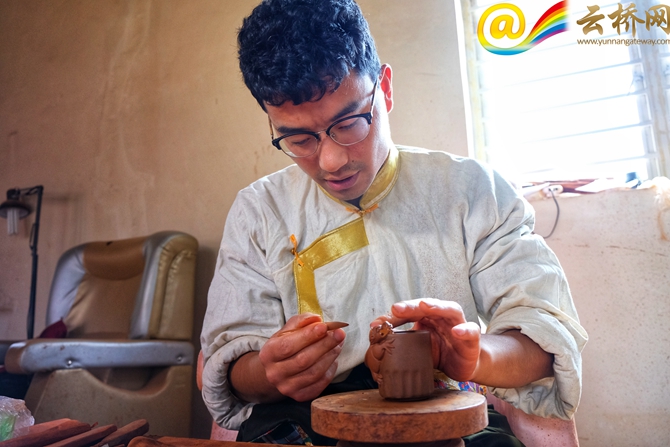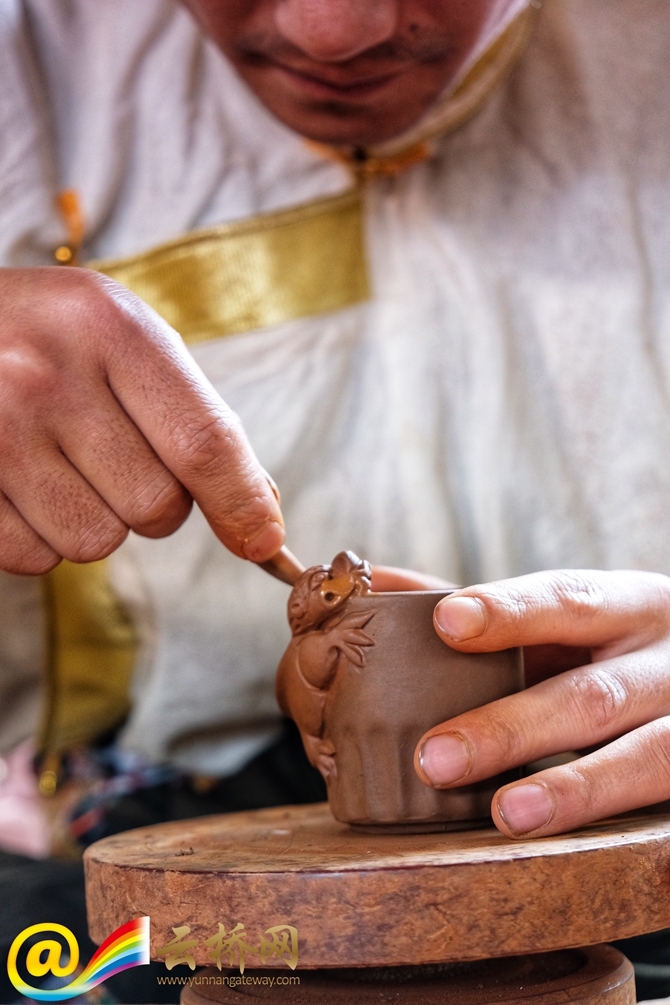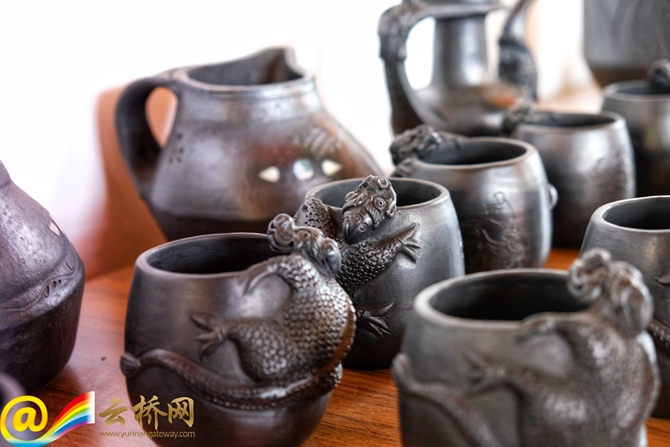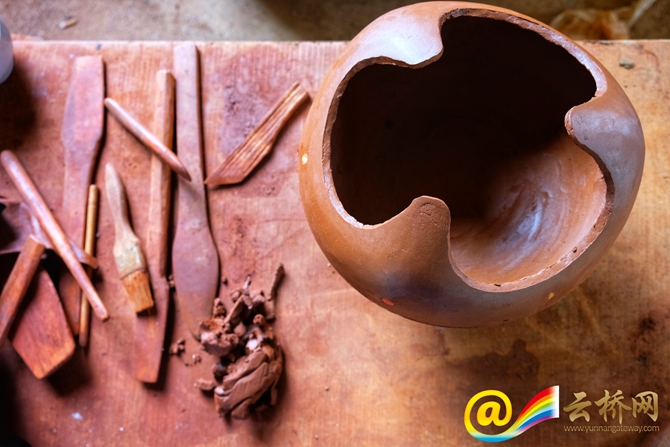|
“香,真香!”黑陶土锅里炖着尼西土鸡,加上当天清晨从山里采摘的松茸,藏式厨房里满是香气。8月27日傍晚,云南省迪庆藏族自治州香格里拉县城来的客人与外地朋友专程到尼西乡品尝美味。 “Wow, it smells great!” In a Tibetan kitchen full of aroma, visitors were admiring the Nixi native chicken stewed in a black pottery pot. The delicacy is coupled with matsutakes picked from the mountains in the morning. On the evening of August 27, a tourist group from afar paid a special visit to Nishi Township, 30 kilometers away from the government seat of Diqing’s Shangri-La City in northwest Yunnan.
“你们猜,这道菜名气最大的是什么?是锅!尼西黑陶是国家级非物质文化遗产!”这番话让外地朋友大吃一惊。于是,问题来了:一口被列为“非遗”的锅是怎样制作出来的? “Can you imagine what matters most for the dish? It's the pot! The Nishi black pottery is a national intangible cultural heritage in China!” The guide’s word was quite beyond the visitors. “So how is a black pottery pot made?” asked a visitor. 在当地向导的带领下,我们一起到尼西黑陶的产地汤堆村探秘。Guided by locals, the visitors explored the Tangdui village, birthplace of the Nishi black pottery. “我爸爸今年刚被评为国家级非遗传承人。不过,他今天不在家。”这一天,26岁的拉茸肖巴(郭文亮)在香格里拉市黑土陶有限责任公司“小鬼当家”。 “My dad was rated as a national inheritor for the heritage earlier this year. However, he’s out now.” That day, the 26-year-old Larong Xiaoba(Guo Wenliang in mandarin) received the guests at the Shangri-La Black Pottery Company, on behalf of his father.
“你会做尼西黑陶土锅吗?”当我们面带疑惑询问这个文质彬彬的小伙子时,他的回答很骄傲:“当然会,我们是黑陶制作世家,我是家族的第8代传人!” “Can you show us how to make a black pottery pot?” A visitor dubiously asked the young fellow, who looked gentle and kind of shy. “Of course. Mine is a family of the black-pottery tradition, and I’m the 8th-generation inheritor.” At the question, Larong Xiaoba got serious and answered with pride. “尼西黑陶有38种传统器型,土锅是其中之一。一位制陶工匠,如果会做38种器型了,那也就出师了。”拉茸肖巴说,金沙江、澜沧江流域的土陶器制作已有近3000年的历史,古老的制陶手艺至今还在尼西传承,造型别致、古朴大气的各类陶器也是当地群众居家生活的必需品。拉茸肖巴从小在家里对黑陶技艺耳濡目染,两年前从云南民族大学藏语言文学专业毕业后回到村里,继续在家里的公司专心学习、工作,38种器型他已经全部学会了。 “The Nishi black pottery falls into 38 traditional varieties, and the pot is one of them,” said Larong Xiaoba. “If you can do all the 38 types of vessels, you’ll be seen as an independent craftsman in black pottery.” Larong has been familiar with black pottery since his childhood. Two years ago, he returned to the village after graduating from the Yunnan Minzu University as a major in Tibetan Language and Literature. He followed his father’s steps and worked for the home business. Now, he can do all the 38 types.
坐在位于汤堆村口的自家工厂里,拉茸肖巴正在小心翼翼地捧着一只杯子,在手里的刻刀雕琢下,杯口一只调皮的水麒麟形象逐渐清晰,似乎已经准备好了在杯中搅起水花。 Sitting in the factory, Larong Xiaoba carefully picked up a clay cup and began carving with a knife. Gradually, the image of a naughty water unicorn became clear. 拉茸肖巴边展示他的手艺边介绍黑陶工艺,他说得滔滔不绝。十几种工具、六七道工艺、两周时间,这是制作一只黑陶杯所需的精力与时间。而黑陶锅的制作,也更为复杂。正是从小练习、技不离身,拉茸肖巴才有了今天这挣钱的“陶饭碗”。但拉茸肖巴选择回归大山,显然不满足于只像前辈一样端一辈子“陶饭碗”,而是想从黑陶开始,开创一片新的天地。从他有些不羁的眼神里,我们看到了梦想的光彩。 Then Larong showed the visitors his black-pottery wares one by one, coupled with detailed instructions on the craft. To finish a black-pottery cup, ten plus tools and seven steps within two weeks are needed. As for making a black-pottery pot, it is necessary to have more tools and go through more steps. Larong Xiaoba’s mastery in the clay art is largely attributed to his family influence. However, the university graduate will not limit himself to the traditional black-pottery field of his forefathers. Based on the craft, he wants to try something new.
拉茸肖巴说,他想先开一家与众不同的民宿,再和当地人一起,把汤堆建设成一个黑陶特色旅游小镇。一身泥的小伙子谈起这个话题,神采奕奕。 Larong said that he plans to open a distinctive rural guesthouse and then join hands with locals to build the village into a tourist town featuring the black-pottery art. At the topic, the young man in muddy clothes got excited and vigorous. 他说,随着香格里格全域旅游不断发展,地处交通要道沿线、坐拥著名非物质文化遗产和美食的尼西已经感受到了旅游带来的热度。这个夏天,拉茸肖巴的家里每天都要迎来数十位来自全国甚至世界各地的游客,他们在这里参观、体验,还可以自己动手制作一个“专属”的黑陶器具,一般情况停留一两个小时,最多半天时间。游客走后,工人师傅会继续这项未完成的工作,待黑陶器具烧制好,拉茸肖巴他们会把成品寄给已经回家的游客,最远甚至寄到过台湾地区。 With growth of the holistic tourism in Shangri-La, the Nixi township also benefited from tourism. The town lies near the thoroughfare and is famous for local heritages and delicacies. This summer, Larong’s home-bred business saw dozens of tourists from home and abroad every day. They came to visit and experience the craft, and some even kneaded their own original clay wares. They generally stay for hours, or half a day at most. Seeing off the visitors, the workers would continue the steps left, and the finished black-pottery products will be sent to the tourists later. Some of Larong’s wares have reached the Taiwan region.
虽然这项体验活动广受好评,但是拉茸肖巴觉得这可远远不够。在他眼里,自己的家乡山清水秀,春有桃花、夏有松茸、民俗独特,游客待一会儿就走,体验太少了。他想和村里人一起,以公司加农户的方式,把当地的各种资源整合起来,让客人在这里待上一天、几天。 Such service has been widely praised, but Larong Xiaoba wants to do better. In his eyes, his hometown is beautiful, with peach blossoms in spring and matsutakes in summer. Folk customs are unique. “Visitors’ staying here is too short to get a full picture of the lovely place,” said Larong. He wants to team up with local villagers and open a guesthouse, so that the visitors can stay here for a day or longer. 在他的梦想里,未来的汤堆要成为一个有意境、有品质、很漂亮、体验好的旅游小镇——桃红柳绿、鸟语花香,人们为出窑的黑陶欢呼,也能坐下来,喝上一碗酥油茶,吃上一锅尼西鸡…… In his vision, the future Tangdui village should be a tourist town of arts, quality, and pleasant stays, and a beautiful place with peach blossoms, lush woods, singing birds and lovely flowers. Here folks and tourists would cheer together for the black-pottery wares coming out of the kiln, and sit together for a drink of the butter tea or a taste of the native chicken...
是的,在今天的尼西乡,黑陶是一种生活方式,仅汤堆村170余户村民中就有140多户从事黑陶制作;黑陶也是一项非物质文化遗产,这门有3000年历史的技艺依然充满了活力。而未来,黑陶更将成为许多像拉茸肖巴这样的尼西年轻人的青春之歌。 Now black pottery is a lifestyle in Nixi Township. Of the 170 plus households of villagers in the Tangdui village, over 140 are engaged in black-pottery making. The 3,000-year cultural heritage has come back to life. In the future, black pottery is expected to be inherited by more Nixi youngsters like Larong Xiaoba. 云报全媒体记者 张若谷 熊燕 储东华 李文君 |
【文化迪庆有传人】拉茸肖巴做黑陶:心里揣着民宿梦
来源:香格里拉网 作者: 发布时间:2018-09-17 16:27:54

频道精选
- 2024 年迪庆州新闻系列综合高级职称定向评审通过人员名单公示2024-09-05
- 香格里拉景区直通车:便捷出行,一站直达美景2024-09-05
- 香格里拉景区直通车:便捷出行,一站直达美景2024-09-05
- 张卫东到迪庆交通运输集团公司开展调研2024-09-05
- 福彩代销者:增强责任意识 倡导理性购彩2024-09-04
- 中央专项彩票公益金的用途及作用|下篇2024-09-04
- 中央专项彩票公益金的用途及作用|中篇2024-09-04
- 中央专项彩票公益金的用途及作用|上篇2024-09-04
- @迪庆人,这场活动需要您的参与!2024-09-04
- 积极参与2024年“99公益日·助力迪庆见义勇为”宣传募捐活动倡议书2024-09-04










